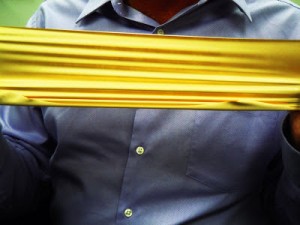Many in our industry use the all-encompassing term “heat transfer vinyl” to refer to any heat transfer flex film. The fact of the matter is that many of the heat transfer films on the market today are not vinyl at all. Much of what is sold today is polyurethane or a polyurethane blend.
The reason that I make this distinction is that there is a big difference between polyurethane and vinyl films. What’s more, a 100% polyurethane film is also quite different than a polyurethane-based blended film. Let me explain the differences.
Polyurethane films are very soft and stretchable. There’s a reason for this. Polyurethane is comprised of very long molecular chains, which provide it with elasticity. By comparison, vinyl is composed of molecules which are very rigid.
To make vinyl films more elastic, plasticizers are added to the formulation. Plasticizers are oils which can leach out of the film, every time the garment is washed. As the plasticizing oils leach out of the vinyl they can cause allergic reactions. Plasticizers have also been linked to other medical issues, which is why some plasticizers have been banned under the Consumer Product Safety Improvement Act (CPSIA) for use in the manufacture of children’s garments.
As plasticizers leach out of a vinyl, the film increasingly becomes more rigid and brittle. Eventually, appliques manufactured from vinyl heat transfer films will crack.
Polyurethane films do not need plasticizers to make them stretchable. These films are naturally elastic. That’s why appliques made from polyurethane heat transfer films retain their flexibility and provide long-term service life. In fact, if garments are washed and dried properly, polyurethane appliques should last as long as the garment itself.
Compared to vinyl heat transfer films, polyurethane films provide other desirable performance properties. Polyurethane is also more abrasion resistant than vinyl, which makes it ideal for punishing athletic applications. Used to decorate performance fabrics, polyurethane films provide the elongation and memory, allowing the appliques to stretch as the fabric stretches.
Caveat emptor
Be aware that not all formulations of polyurethane films are the same. While all of the RTape/SEF heat transfer films are 100% polyurethane, many other competitive products are classified as “polyurethane based”. These polyurethane based films are blends of polyurethane and vinyl. Because these blends contain PVC, they may not be CPSIA or OekoTex Standard 100 compliant.
With the addition of vinyl to their formulations, polyurethane-based films are also typically stiffer, less elastic and not so durable as 100% polyurethane.



